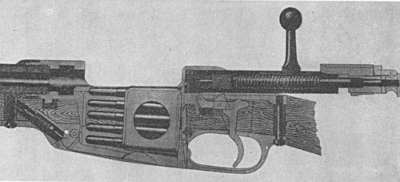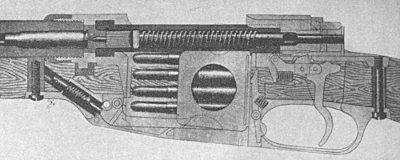The following information on the Gewehr 88 comes from Chapter 11 of Mauser Rifles and Pistols by W. H. B. Smith. Mauser Rifles and Pistols is also available to purchase in print.
The Gewehr 88 has been the subject of controversy among gun experts for years. Because the rifle was loaded with a clip resembling that of the Mannlicher and based on his patents, it is often mistakenly referred to as the “Mannlicher” or as the “Mauser-Mannlicher.” Its official designation was “German Infantry Model 1888”; but it is often listed in Germany as “Mauser and Commission.”
This rifle was actually a development of the German Infantry Board or Commission and no receiver of this model ever bears the Mauser factory stamp. These arms were manufactured in huge numbers in a Mauser plant, but in 1888 finances of the Mauser Company had been taken over by the giant German firm of Ludwig Loewe and Company of Berlin and such rifles are usually stamped “Loewe, Berlin 1888, 1890, 1891” or simply “Gew. 88.”

Gewehr 88’s were also manufactured by all the standard government arsenals, and by such well-known makers as Haenel, Schilling, Sauer and Sohn at Suhl; and by Steyr in Austria. In 1889 arrangements were made for manufacture of rifles of this type in Belgium by Auguste Schriever et Cié at Liege. In the official Mauser plant record “Mauser Gewehr und Patente,” published in 1936, is found the statement that Mauser submitted design ideas to the Commission and was very annoyed when they passed over his design recommendations. Indeed, Paul Mauser was extremely bitter about the adoption of this rifle, contending it was inferior to his newer experimental designs. Time, incidentally, proved that Mauser was right.
In the early official catalogues of Ludwig Loewe and Company, manufacturers of genuine Mausers during that period, is found the following statement: “In this rifle (Gewehr 1888) there was retained the approved breech closing mechanism of the Mauser rifle pattern 1871 with slight alterations, and there was combined within the cartridge holder from the Austrian Mannlicher rifle.
“This latter feature, however, was not adopted without an important alteration made by the Small Arms Inspection Committee in Spandau, which alteration made it possible to arrange or pack the cartridges symmetrically, and introduce the packet into the magazine with either side uppermost. The cartridge holder constructed by Mannlicher up to that date had a rhomboid form and could therefore only be introduced into the magazine in one particular way i.e., the holder had an upper and a lower side, and the lower side must always enter the magazine first.”
Among the other “minor modifications,” so called, was the use of front locking lugs on the bolt which provides the most secure breech locking system ever developed.
This system of forward locking lugs had been used in the United States on a breech loading, bolt action, cap-and-ball rifle developed by Colonel J. Durrell Greene of the U.S. Army. This rifle patented November 17, 1857 was unsuccessful because metallic cartridges which would seal the breech against escape of gas had not been perfected at that time.

The Packet-Loading (or Charger-Clip Loading) System
The Mannlicher system of packet loading was introduced to speed up loading, as one motion charged the magazine.
In this Mannlicher system of packet or multiple loading, 5 (or more) cartridges are held together fairly parallel to each other by a clip of sheet metal which covers the rear sides of the cartridges for approximately half their length, and fully encloses and guides the cartridge case heads. The fully loaded clip is placed in the receiver when the bolt has been turned and withdrawn and the clip and cartridges as a unit are pressed into the magazine where they are held down by a latch which engages in a projection on the back of the clip.
In operation, the bolt functioned in approximately the same manner as all the earlier Mauser rifles. When the handle was turned up and drawn back the packet could be inserted. Pushing the bolt forward stripped the top cartridge from between the lips of the clip (or “packet”) and chambered it. The extractor snapped into the cannelure of the new cartridge, which was rimless.
After firing, the bolt was raised to unlock, then pulled back to extract and eject the empty case. A spring-controlled follower in the form of a lever was forced up by a spring against the bottom cartridge in the clip. The top and bottom of the clip, while cut away and folded over with lips to retain the cartridges, is open enough to permit the magazine follower to ride up between the clip sides.
This lever acted on by the spring forced each cartridge up successively into line as the bolt was drawn back. When the last cartridge had been driven into the chamber, the clip was free to fall out through a hole cut in the bottom of the magazine well. As long as there were any cartridges in the clip, it was necessary to release the catch by pressing on the thumb piece at the front end of the trigger guard to unload. This released the clip and its contents to be pushed up out of the action by the follower. The hole in the bottom of the magazine was not long enough to permit a loaded cartridge or the clip with cartridges in it to drop out. Only the empty clip could pass through it.
This rifle design has several defects. It can normally be used as a single loader only when the magazine is empty. Furthermore the magazine cannot be reloaded by introducing individual cartridges; it must be clip loaded, since the clip itself is an actual part of the magazine.
A partially filled Mannlicher clip in the action makes it impossible to load the chamber or magazine with a spare cartridge. In the Mauser system, the chamber can be loaded by pushing the cartridges down in the magazine, easing the bolt forward over their heads, then inserting a cartridge in the chamber and closing the bolt. A partially empty Mauser magazine can be filled with single cartridges anytime the action is open. The essential difference is that in the Mannlicher the clip goes in with the cartridges; while in the Mauser the cartridges are stripped in off the clip.
A thin steel jacket (or “barrel casing”) around the barrel was intended to protect the rather thin-walled barrel from injuries and to protect the hands of the soldier from being burned by the heat generated during rapid fire.

Specifications
The Gewehr 88 rifle introduced an entirely new and outstanding cartridge known as the 7.9 mm. (It is also listed as 7.91 and 7.92 mm). That design is the basis of the cartridge used by Germany from then on until the close of World War II. Except for ballistic changes in the shape of the bullet and the type of charge it is the same cartridge—one of the most efficient known.
While the nominal caliber is 7.9 mm, both manufacturers and War Ministry publications list a maximum diameter for the bullet of 8.1 mm for the Gewehr 1888. The bore diameter is listed as 7.9 mm.
This cartridge (popularly known as “8 mm” Mauser in the U.S.) is the German 8x57mm rimless. It was originally issued with round nosed bullet. Bullet weights and styles, as well as loads, have varied with time and place of manufacture. Bullet diameter is about .318 inch.
The rifle measured 48.8 inches over all and weighed 8.4 pounds. The barrel was 29.1 inches long and had a barrel groove diameter of about .320 inch, 4-groove rifling to the right, one turn in 9.45 inches.
Sights were graduated from 500 to 4000 meters.
